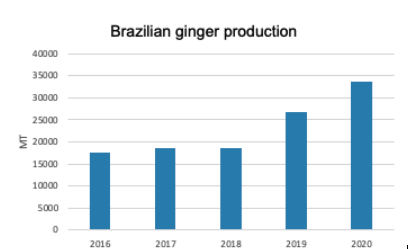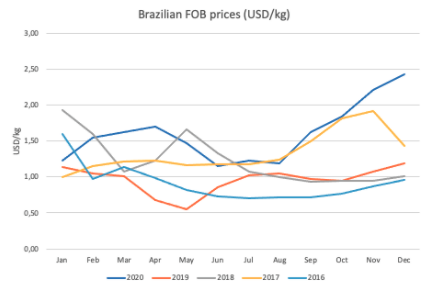Brazilian ginger increase in prices in 2021
The most common ginger variety produced in Brazil is the Chinese giant yellow, which takes about nine months to mature and be ready to harvest. The season starts with young ginger around March and the peak harvest season from the end of April to August, but still with reasonable volumes up until December. Once mature, the ginger can stay in the ground for years and wait to be harvested since they keep plants healthy and soil moisture conditions ideal, allowing harvest at the off-season as well in a smaller quantity when available. The Brazilian ginger production has been on an increasing trend for the past five years, with a record crop in 2020 with 33.600 MT. On top of this, ginger consumption has increased globally during the pandemic due to its anti-inflammatory properties, achieving high prices, encouraging producers to increase their 2021 crop which is expected to surpass last year’s record.

Source: Safra ES
In 2021, Brazilian ginger production had favorable weather conditions for its growth, and the dry year reduced the risk of disease in the roots, guaranteeing its high quality. This year’s season started in April with the young ginger and by May the mature ginger started to be harvested. Although currently in the peak harvesting period, the price of ginger has been increasing since May, showing an increase of 10 to 15%. There is a combination of reasons for this increase. In June, USD devalued by 10% compared to BRL, making Brazilian ginger more expensive for international trade. On top of this, the global shortage of refrigerated containers (reefers) has stalled and delayed all fresh produce exports, including ginger. The delays over reefers shortage are reaching a month, and there are virtually no bookings available on-demand, all reefers must be arranged preferably more than a month in advance. The reefers shortage is not only causing the delays but also a surge in its rentals and freight prices, contributing to the increase in ginger prices. Furthermore, the delay is causing a short-term supply shortage of ginger in importing countries, pushing its prices up.
Although harvest is delayed, farmers are not too worried, since the ginger can keep growing on the ground while it waits for reefers to be available and the global demand for ginger is increasing throughout the year. Also, producers can have their ginger processed from harvest to shipping within two weeks, giving plenty of time to comply with the minimum booking time frame needed at the moment for the reefers. Moreover, during 2020, Brazil has exported its ginger to more than 50 countries, giving plenty of opportunities for export.
Further increase in prices
The peak season for the ginger harvest finishes around August, at which time prices start to rise, with the highest around December and January. In 2020, there was the largest difference in prices of high and low season in the last five years. December 2020 ginger price was 110% higher than its price in the peak season in June of the same year. The high demand during the pandemic pushed its prices to new records. This year, farmers expect a slightly lower increase, but still comparable to last year.

Source: Comex
Sources:
- Comex. Translated from Portuguese. Export data.
- Safra ES. Translated from Portuguese. "Ginger, an Brazilian business"
- Exchange rates. "USD-BRL exchange rate history"
